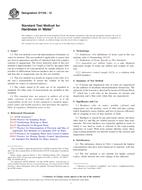1.1 These test methods cover the determination of the specific gravity of soil solids that pass the 4.75-mm (No. 4) sieve, by means of a water pycnometer. When the soil contains particles larger than the 4.75-mm sieve, Test Method C127 shall be used for the soil solids retained on the 4.75-mm sieve and these test methods shall be used for the soil solids passing the 4.75-mm sieve.
1.1.1 Soil solids for these test methods do not include solids which can be altered by these methods, contaminated with a substance that prohibits the use of these methods, or are highly organic soil solids, such as fibrous matter which floats in water.
Note 1 – The use of Test Method D5550 may be used to determine the specific gravity of soil solids having solids which readily dissolve in water or float in water, or where it is impracticable to use water.
1.2 Two methods for performing the specific gravity are provided. The method to be used shall be specified by the requesting authority, except when testing the types of soils listed in 1.2.1
1.2.1 Method A – Procedure for Moist Specimens, described in 9.2. This procedure is the preferred method. For organic soils; highly plastic, fine grained soils; tropical soils; and soils containing halloysite, Method A shall be used.
1.2.2 Method B – Procedure for Oven-Dry Specimens, described in 9.3.
1.3 All observed and calculated values shall conform to the guidelines for significant digits and rounding established in Practice D6026.
1.3.1 The procedures used to specify how data are collected/recorded and calculated in this standard are regarded as the industry standard. In addition, they are representative of the significant digits that generally should be retained. The procedures used do not consider material variation, purpose for obtaining the data, special purpose studies, or any considerations for the user’s objectives; and it is common practice to increase or reduce significant digits of reported data to be commensurate with these considerations. It is beyond the scope of these test methods to consider significant digits used in analysis methods for engineering design.
1.4 The values stated in SI units are to be regarded as standard. The inch-pound units given in parentheses are mathematical conversions which are provided for information purposes only and are not considered standard.
1.5 This standard does not purport to address all of the safety concerns, if any, associated with its use. It is the responsibility of the user of this standard to establish appropriate safety and health practices and determine the applicability of regulatory limitations prior to use.
Product Details
- Published:
- 01/01/2010
- Number of Pages:
- 7
- File Size:
- 1 file , 120 KB
- Redline File Size:
- 2 files , 210 KB


